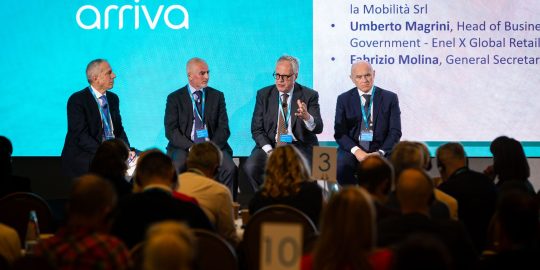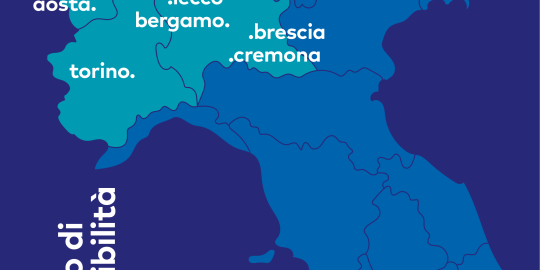A new step toward green transition: Arriva Udine unveils new 100% electric city buses
They will enter service from January 9, 2023 on the new Centro Storico circular line
Important news in Arriva Udine’s vehicle fleet: the new electric city buses are ready to enter service. The vehicles, distinguished by a special livery that makes them immediately recognizable, were presented today in Udine’s Piazza della Libertà by Angelo Costa, managing director of Arriva Italia and president of Arriva Udine, and Aniello Semplice, managing director of Arriva Udine and TPL FVG, in the presence of Udine Mayor Pietro Fontanini and F.V.G. Region Finance Councillor Barbara Zilli.
The long-awaited news is a reality: the 3 new full electric city buses, financed, thanks to the strong and effective action of the FVG Region, through the funds of the National Plan of Complementary Investments to the National Plan for Recovery and Resilience (PNRR), will enter service after the holidays, starting January 9, on the new Circular City Center line.
The state-of-the-art YUTONG-branded buses (8.9 meters long and 2.4 meters wide), offer 52 seats, 21 of which are seats, as well as seating for people with mobility disabilities.
In these new vehicles that are being added to the AU fleet, safety also occupies a central position: the buses are equipped with a collision hazard warning system, an automatic fire extinguishing system for electrical compartments and batteries, and internal and external cameras for on-board video surveillance. As these vehicles are extremely quiet, a safety system has also been introduced that generates noise until 25 km/h is reached.
For maximum travel comfort, there are: a platform and station for wheelchair users with mobility disabilities, padded fabric seats, on-board Wi-Fi with secure connection, USB sockets available to passengers, and double-sided information monitors.
The new buses consume less than one kilowatt per kilometer-thanks to significant energy recovery during braking-and recharge in plug-in mode in about 2 1/2 hours. For charging the newcomers, the company has purchased No. 2 individual 100 kW columns. Charging activities are scheduled after the vehicles return from 9 p.m. onwards. Any daytime charging operations will use some of the energy produced for self-consumption by the photovoltaic system at the Partidor Street office.
“Arriva Udine has taken up – together with the other companies of the FVG TPL Consortium – the challenge launched by the FVG Region, first to define a Strategic Plan for the renewal of the TPL fleet for the next 10 years, then to develop concrete actions such as to put on the ground as quickly as possible the projects that are gradually being defined. In this context,” says Aniello Semplice, “fit the zero-emission electric buses that we are putting at the service of the territory today and that constitute a new step on the path toward decarbonization in a city that is concretely oriented toward guaranteeing citizens sustainable, quality and technologically advanced mobility.
“These important steps in terms of environmental sustainability, safety, technologies and investment in support facilities,” says Angelo Costa, CEO Arriva Italy, “are proof of how hard we are working to restore value to this territory. The year 2022 has been a year of growth: urban lines 2, 3 and 4 in Udine have been extended, coming to cover areas not previously served, and the activation of the Centro Storico circular is now imminent, all innovations that result in a better travel experience for the entire community.
Arriva Udine aims to become the best choice for people’s mobility by positioning itself, at a time of economic hardship, as a credible alternative to private mobility, offering a service that is always efficient, safe and greener: a goal that is getting closer and closer thanks to the inclusion in the fleet of these electric buses, which join the recently introduced suburban vehicles powered by compressed natural gas.”
“Reducing emissions and safety,” says Udine Mayor Pietro Fontanini, “are the concepts that underlie the philosophy with which Arriva Udine is making its concrete contribution so that the city of Udine will succeed in becoming a national and European model in the field of environmental sustainability in the coming years. The arrival of these three fully electric and fully equipped urban vehicles, which will be destined for the Circular Historic Center, are a demonstration of this logic and fit perfectly into the choices made by this Administration to make our city increasingly green.
Thanks go to the FVG Region for intercepting PNRR funds for this purpose and to Arriva Udine for the commitment and seriousness with which it is sinking this historic challenge for our city.”
“This is the first all-electric line at the regional level,” explains Finance Councillor Barbara Zilli. “Thanks to this investment, the path of fleet renewal envisaged by Regional Law 2021 is set in motion. The program will make it possible to define an evolution of the bus fleet from the point of view of alternative fuels, taking advantage of various state funding strands in the framework of what is also provided by the contract with the regional LPT. The region’s goal is ambitious: by 2030, half of the regional diesel buses will be replaced by new vehicles with low- or zero-impact alternative fuels: hydrogen, electric or LNG/GNL.”
“Today’s is an initial purchase,” Zilli further explains, “which will be followed by others to ensure a substantial renewal in the near future. Udine is acting as a forerunner for an experimental project that will touch all urban contexts in which the transport service is provided. The three vehicles purchased are small in size to allow easy passage through downtown areas and facilitate maneuvering. The region is continuing its forward-looking action to encourage the use of public transportation, and the new line in Udine’s historic center is just the first of the innovations being studied with local authorities. The goal is to further develop sustainable mobility by facilitating transit between the center and suburbs and also enhancing intermodal exchanges.” “The regional administration’s attention to the issue is confirmed by the latest allocations in the recently approved Budget,” Zilli concludes.
“The Fedriga Council passed an amendment dedicated to a 50 percent cut in the cost of public transportation for everyone over 65, with no Isee limit. In addition, to better manage the difficult situation of LPT companies, 3 million euros have been earmarked against high energy prices. There are also new grants for those wishing to obtain a D, DE license and driver qualification card. A 400,000 euro measure to solve the driver shortage problem.”




